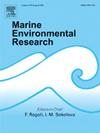Strong seasonality and unsuspected diversity of haptophytes explored by metabarcoding analysis in the Chinese seas
IF 3
3区 环境科学与生态学
Q2 ENVIRONMENTAL SCIENCES
引用次数: 0
Abstract
The haptophytes, are essential components of the marine pico- and nano-plankton but little is known about their diversity and abundance due to the small size. In this study, the taxonomic composition, geographical distribution, and seasonal variation of the haptophytes in the Bohai Sea, the Yellow Sea, and the East China Sea were investigated using DNA metabarcoding in April and October of 2021. A total of 623 and 3756 haptophyte amplicon sequence variants (ASVs) were obtained in spring and autumn, respectively. All currently described or detected haptophyte orders were retrieved, including several deep-branching novel environmental lineages with relative high abundance. The predominant groups were Chrysochromulina, Clade HAP 2-3-4-5, Phaeocystis, and Prymnesium in spring, and Chrysochromulina, Phaeocystis, and Emiliania/Gephyrocapsa compelx in autumn. The richness and diversity showed seasonal variation, with higher alpha diversity occurred in autumn than that of spring. Different haptophyte taxa exhibited unique spatial distribution patterns and water temperature was significantly correlated with the observed community dissimilarities and was the most influential driving factor in both seasons. Our results highlight the high hidden diversity and seasonal variations of haptophytes in the Chinese seas.
通过代谢编码分析探索中国海域七鳃鳗的强烈季节性和未知多样性
七鳃鳗是海洋微米级和纳米级浮游生物的重要组成部分,但由于体型较小,人们对其多样性和丰度知之甚少。本研究于 2021 年 4 月和 10 月,利用 DNA 代谢编码对渤海、黄海和东海的七彩生物的分类组成、地理分布和季节变化进行了调查。在春季和秋季分别获得了 623 个和 3756 个七彩生物扩增子序列变体(ASVs)。检索到了目前已描述或检测到的所有七彩生物目,包括几个丰度相对较高的深分支新环境系。春季的主要类群为 Chrysochromulina、Clade HAP 2-3-4-5、Phaeocystis 和 Prymnesium,秋季的主要类群为 Chrysochromulina、Phaeocystis 和 Emiliania/Gephyrocapsa compelx。丰富度和多样性呈现季节性变化,秋季的α多样性高于春季。不同的七鳃鳗类群表现出独特的空间分布模式,水温与观察到的群落差异显著相关,是两个季节中影响最大的驱动因素。我们的研究结果凸显了中国海域七彩生物的高度隐蔽多样性和季节性变化。
本文章由计算机程序翻译,如有差异,请以英文原文为准。
求助全文
约1分钟内获得全文
求助全文
来源期刊

Marine environmental research
环境科学-毒理学
CiteScore
5.90
自引率
3.00%
发文量
217
审稿时长
46 days
期刊介绍:
Marine Environmental Research publishes original research papers on chemical, physical, and biological interactions in the oceans and coastal waters. The journal serves as a forum for new information on biology, chemistry, and toxicology and syntheses that advance understanding of marine environmental processes.
Submission of multidisciplinary studies is encouraged. Studies that utilize experimental approaches to clarify the roles of anthropogenic and natural causes of changes in marine ecosystems are especially welcome, as are those studies that represent new developments of a theoretical or conceptual aspect of marine science. All papers published in this journal are reviewed by qualified peers prior to acceptance and publication. Examples of topics considered to be appropriate for the journal include, but are not limited to, the following:
– The extent, persistence, and consequences of change and the recovery from such change in natural marine systems
– The biochemical, physiological, and ecological consequences of contaminants to marine organisms and ecosystems
– The biogeochemistry of naturally occurring and anthropogenic substances
– Models that describe and predict the above processes
– Monitoring studies, to the extent that their results provide new information on functional processes
– Methodological papers describing improved quantitative techniques for the marine sciences.
 求助内容:
求助内容: 应助结果提醒方式:
应助结果提醒方式:


